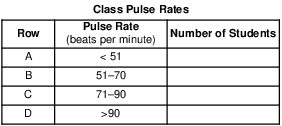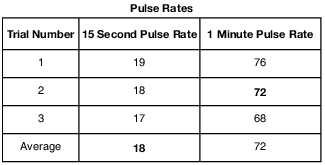Topic: Lab Making Connections
Lab Making Connections
Five students design an experiment to answer the question: “How is heart rate affected by running?” Two chairs were set up at different ends of a large room. The pulse rate of each student was taken at rest just before running. Each of the five students ran between the chairs a different number of times. Their pulse rates were taken after running and the results are shown in the table below.

If a control group is not included in an experiment, it would be difficult to
(1) formulate a hypothesis for the experiment
(2) make observations about the experimental group
(3) record data in a data table
(4) draw a valid conclusion
A student is opening and closing clothes- pins as part of a lab activity. The student begins to experience muscle fatigue, and the rate at which the student is opening and closing the clothespins slows.
The fatigue is due to
(1) an increase of metabolic waste products in the muscles
(2) an increase in the pulse rate of the student
(3) a decrease of metabolic waste products in the muscles
(4) a decrease in the pulse rate of the student
A class is recording pulse rates of the students in a data table like the one shown below.

One student checks his pulse and counts 23 beats over a time interval of 20 seconds. In which row in the data table should the pulse rate of this student be recorded?
(1) A
(2) B
(3) C
(4) D
When people exercise, their body cells build up more waste quickly. Which two body systems work together to remove these wastes from their cells?
(1) immune and endocrine
(2) digestive and skeletal
(3) respiratory and circulatory
(4) circulatory and digestive
An experiment was conducted to determine the effect of activity on pulse rate. Data were collected and recorded in the table below.

Which activity most likely corresponds to the pulse rate of the person while sleeping?
(1) 1
(2) 2
(3) 3
(4) 4
A student collected data from an experiment on muscle fatigue. In order to interpret these data, the student should
(1) ignore the data because they do not support their hypothesis
(2) recalculate the data so that the numbers are easier to work with
(3) share the data with a student who has none
(4) organize the data into a table or graph
To determine the effect of fatigue on the action of muscles, each of five boys was given a 12-cm clothespin and each of five girls was given a 10-cm clothespin. The students squeezed the clothespins for 30 seconds and recorded the results. After the first trial, the girls rested and the boys jogged in place for 1 minute. A second trial was then done to determine how many times each student could squeeze the clothespin in 45 seconds. Identify one error in the design of this experiment. [1]
Allow 1 credit. Acceptable responses include, but are not limited to:
• — Each trial should have more students.
• — The clothespins were of two different sizes.
• — The time intervals for the two trials were unequal.
• — The boys and girls should not have been in separate groups.
Identify one specific substance necessary for muscle activity that is delivered to muscles more effectively as a result of increased heart rate. [1]
Allow 1 credit. Acceptable responses include, but are not limited to:
• — oxygen
• — glucose
A student hypothesized that drinking tea would cause an increase in pulse rate. He measured his pulse 20 minutes after drinking a glass of tea. It was 86 beats per minute. State one error in the experiment. [1]
Allow 1 credit. Acceptable responses include, but are not limited to:
• — There is no control.
• — He did not determine his pulse rate before drinking the tea.
• — He should have measured his pulse more than one time.
A student measured her pulse rate for a 15-second period, three separate times, and recorded the results. She then calculated her pulse rate for 1 minute. Complete the data table below by filling in the missing information. [1]

Allow 1 credit for completing the data table as shown below.
• 
A student proposes that, if volunteers warm up before squeezing a clothespin for one minute, they will increase the number of times that they can squeeze it without tiring. He states that this is because their muscles will be better prepared for exercise. The data from an experiment are shown in the data table below.

Which trial from the chart above provides the best data to support his claim? Support your answer. [1]
Trial: ___________
Allow 1 credit for stating which trial from the above chart provides the best data to support his
• claim and supporting the answer. Acceptable responses include, but are not limited to:
• — Trial 2, because more students were used.
• — Trial 2, because they squeezed more when they warmed up first.
• — Neither, because the averages were not very different.
Pulse rate is measured in beats per minute (bpm). Individual A has a resting pulse rate of 64 bpm. Individual B has a resting pulse rate of 82 bpm. Identify two reasons why the pulse rates of both of these individuals could be considered “normal.” [1]
Reason 1:
Reason 2:
Allow 1 credit for two reasons. Acceptable responses include, but are not limited to:
• — They have different body types.
• — different sexes
• — different ages
• — different weights
In order to determine the effect of muscle fatigue on the ability of students to squeeze a clothespin, five male students did jumping jacks for three minutes and then squeezed a clothespin as many times as possible in a minute. Three other male students ran up and down the stairs for 30 seconds and then squeezed a clothespin as many times as possible for one minute. The results of the two groups were recorded. Identify one change that could be made to the experiment to increase the validity of the conclusion made from these results. [1]
Allow 1 credit. Acceptable responses include, but are not limited to:
• — Increase the sample size of both groups.
• — Keep the exercise/time of exercise for each group the same.
• — A control group that does not exercise should be included in the design of the investigation.
• — Have equal numbers of males in both groups.
• — Both groups should include equal numbers of males and females.
• — Repeat the experiment.
• — Take a resting pulse rate.
During a laboratory activity, students ran in place for three minutes. Students then complained of muscle fatigue in their legs. State one biological reason why the students experienced muscle fatigue after exercising. [1]
Allow 1 credit. Acceptable responses include, but are not limited to:
• — Wastes built up in muscles/muscle cells.
• — Not enough oxygen was available to muscle cells.
• — Anaerobic respiration occurred.
A class carried out an experiment to test the effect of rest time after exercise on the breathing rate. Each member of the class ran up and down stairs for 60 seconds. After exercising, they rested. The students then measured their rate of respiration by counting the number of inhales and exhales per minute for 7 minutes. The class then averaged their data.
Provide a biological explanation for why the breathing rate decreases several minutes after physical activity has stopped. [1]
Allow 1 credit. Acceptable responses include, but are not limited to:
• — Since muscle cell activity is reduced, oxygen demand decreases.
• — The cells are producing less carbon dioxide/waste products during rest periods.
• — Homeostasis is being restored.
• — The body is returning to normal after the activity stops.
